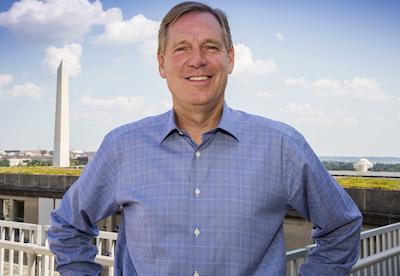
As President and CEO of the National Park Foundation, Will Shafroth has overseen a fundraising campaign that started out with a $250 million goal and now is aiming for $350 million/National Park Foundation
Two million dollars to help remove 500 tons of debris at Point Reyes National Seashore. Twenty-three-million dollars committed for land acquisition at Grand Teton National Park. Another $2 million to help open Stonewall National Monument.
Those are just three examples of putting charitable dollars raised by the National Park Foundation to work in the National Park System, but they don't tell the entire story. While Congress has been slow to tackle the National Park Service's maintenance backlog, estimated at about $12 billion, the Foundation has found great support for the parks through its philanthropic outreach and has been putting the dollars to work in the parks.
Other areas where charitable dollars are at work include Olympic and Mount Rainier national parks in Washington State, where $2 million is being used to fund a conservation corps, at Belmont-Paul Women’s Equality National Monument in Washington, D.C., where $1 million is being used to repair and restore the landmark building, and for President Obama's Every Kid in A Park program, into which the Foundation has invested $4 million.
Through mid-August the Foundation had raised about $235 million towards a $350 million goal. And with the campaign running through the end of 2018, the organization just might need to bump that ceiling a bit higher as Americans, from individuals and foundations to corporations, have stepped up in this, the National Park Service's centennial year.
"We started out with a $250 million campaign goal. When I got here last May, I think they were about $100 million towards that goal," recalled Will Shafroth, president and CEO of the Foundation. "I’ve done a lot of fundraising in my life and I was a little intimidated by (having to raise) another $150 million, but things really started moving in a positive direction."
So strongly has the campaign performed that the $250 million goal was pushed up to $350 million. With "a couple of potentially significant things" expected to happen in the coming six weeks, donation wise, that goal could become not only more attainable, but on a pace ahead of schedule, he said.
"Our momentum is strong," Mr. Shafroth said during a phone call from his Washington office. "Our campaign does not end for another 26 months, and I will put this responsibility significantly on the vice chairman of my board, who is relentless in cracking the whip on us around fundraising. And it's paying off. We’re seeing all sorts of good things. I’m prepared to say we have a couple big things in the pipeline, and if they happen we’ll need to raise our goal.”
Talk of campaigns raising hundreds of millions of dollars wasn't always heard in the Foundation's hallways, he noted, though giving has steadily increased in recent years, from roughly $16.5 million back in 2011 to $20.5 million in 2013 and $73.5 million in 2015.
David Rubenstein alone has pumped more money into the National Park System in recent years. This past February he donated $18.5 million for needed work on the Lincoln Memorial, and that came on top of $25 million he's given since 2012: $7.5 million to restore the Washington Monument after the earthquake in 2011; $12.35 million to restore Arlington House, The Robert E. Lee Memorial, in 2014, and; $5.37 million to refurbish the U.S. Marine Corps War Memorial in 2015.
He alone is a key reason why the Foundation can point to roughly $135 million in individual contributions towards that $350 million goal.
“The good thing about (the donations) is it’s pretty balanced. We’ve gotten about $50 million each raised from corporate contributors and $50 million from foundations, and the remainder, which is about $135 million or so, from individuals. So that’s direct mail, stewardship circles, who are people who give $1,000 to $25,000, and major donors on top of that. It’s a pretty balanced approach," said Mr. Shafroth. "The fact that we’ve gotten such strong support from foundations and corporations has been really helpful.”
No doubt the groundswell of admiration for the national parks during the Park Service's centennial year is driving the giving, and not only at the national level.
- Friends of Acadia last month launched a $25 million campaign for Acadia National Park...with $20 million raised by the time the campaign went public.
- The Grand Teton National Park Foundation has pledged to raise some $17 million for restoration of the Jenny Lake area in the park, and now is working with the National Park Foundation to raise $46 million by year's end to purchase 640 acres known as the Antelope Flats Parcel from the state of Wyoming.
- Across the country, the Blue Ridge Parkway Foundation has embarked on a multi-phase effort to restore the Moses H. Cone Memorial Park, with an initial goal of $411,632 to go along with a Centennial Challenge award from Congress of $294,487.
- Friends of Saguaro aims to raise $25,000 by Thursday, the Park Service's 100th birthday, to help Saguaro National Park's trails, habitat, wildlife, and environmental education programs.
Will the giving continue beyond August 25?
"Our campaign doesn’t end until the end of 2018, so we’re going to try to maximize the value of the centennial beyond," said Mr. Shafroth. "It’s like any fundraising campaigin, there’s very rarely an end date like the centennial. In some ways, we’re just hitting our stride. As an organization we just finally, I thnk we’re finally fulfilling our potential. We’re beginning to fulfill our potential as an organization in support of the parks."



Add comment